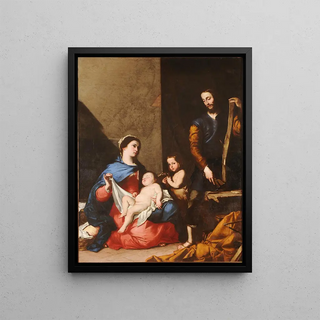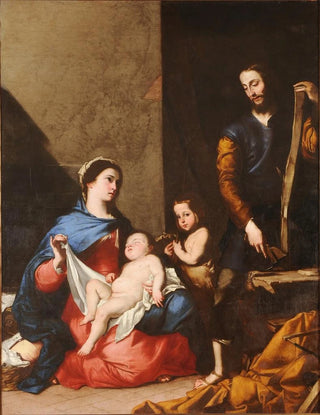Art print | The Holy Family - Jusepe de Ribera


View from behind

Frame (optional)
La Sainte Famille - Jusepe de Ribera – Captivating Introduction
In the rich and complex universe of baroque art, "La Sainte Famille" by Jusepe de Ribera stands out as an emblematic work, revealing the spiritual depth and emotional intensity characteristic of this period. This painting, depicting the daily life of the Holy Family, is a true invitation to delve into the intimacy of its characters. The composition, both harmonious and dynamic, captures the eye and the mind, transporting the viewer into a world where sacrality blends with the simplicity of everyday life. Through this artwork, Ribera manages to express the tenderness and complicity that unite Mary, Joseph, and the Child Jesus, while evoking an atmosphere of serenity and devotion.
Style and uniqueness of the work
Ribera's work is characterized by a masterful use of light and shadow, a fundamental principle of chiaroscuro that gives an almost sculptural dimension to the figures. In "La Sainte Famille," the soft light illuminating the faces and hands creates a warm atmosphere, inviting contemplation. The meticulously detailed elements, from drapery to facial expressions, demonstrate a particular attention to the humanity of the characters. The choice of colors, both rich and nuanced, adds emotional depth to the scene. Every element is carefully arranged to reinforce the spiritual message of the artwork, making this representation a true masterpiece of religious art.
The artist and his influence
Jusepe de Ribera, born in Spain and active in Italy, is one of the masters of Spanish baroque. His style, marked by great expressiveness and striking realism, has influenced many contemporary and later artists. Ribera, often called "Lo Spagnoletto," skillfully combined Italian tradition with Spanish sensibility, creating works that capture life in all its complexity. His fascination with the human body and his ability to portray suffering and beauty with such intensity make him an essential figure in art history. "La Sainte Famille" fits within this lineage, testifying to his commitment to

Matte finish

View from behind

Frame (optional)
La Sainte Famille - Jusepe de Ribera – Captivating Introduction
In the rich and complex universe of baroque art, "La Sainte Famille" by Jusepe de Ribera stands out as an emblematic work, revealing the spiritual depth and emotional intensity characteristic of this period. This painting, depicting the daily life of the Holy Family, is a true invitation to delve into the intimacy of its characters. The composition, both harmonious and dynamic, captures the eye and the mind, transporting the viewer into a world where sacrality blends with the simplicity of everyday life. Through this artwork, Ribera manages to express the tenderness and complicity that unite Mary, Joseph, and the Child Jesus, while evoking an atmosphere of serenity and devotion.
Style and uniqueness of the work
Ribera's work is characterized by a masterful use of light and shadow, a fundamental principle of chiaroscuro that gives an almost sculptural dimension to the figures. In "La Sainte Famille," the soft light illuminating the faces and hands creates a warm atmosphere, inviting contemplation. The meticulously detailed elements, from drapery to facial expressions, demonstrate a particular attention to the humanity of the characters. The choice of colors, both rich and nuanced, adds emotional depth to the scene. Every element is carefully arranged to reinforce the spiritual message of the artwork, making this representation a true masterpiece of religious art.
The artist and his influence
Jusepe de Ribera, born in Spain and active in Italy, is one of the masters of Spanish baroque. His style, marked by great expressiveness and striking realism, has influenced many contemporary and later artists. Ribera, often called "Lo Spagnoletto," skillfully combined Italian tradition with Spanish sensibility, creating works that capture life in all its complexity. His fascination with the human body and his ability to portray suffering and beauty with such intensity make him an essential figure in art history. "La Sainte Famille" fits within this lineage, testifying to his commitment to






